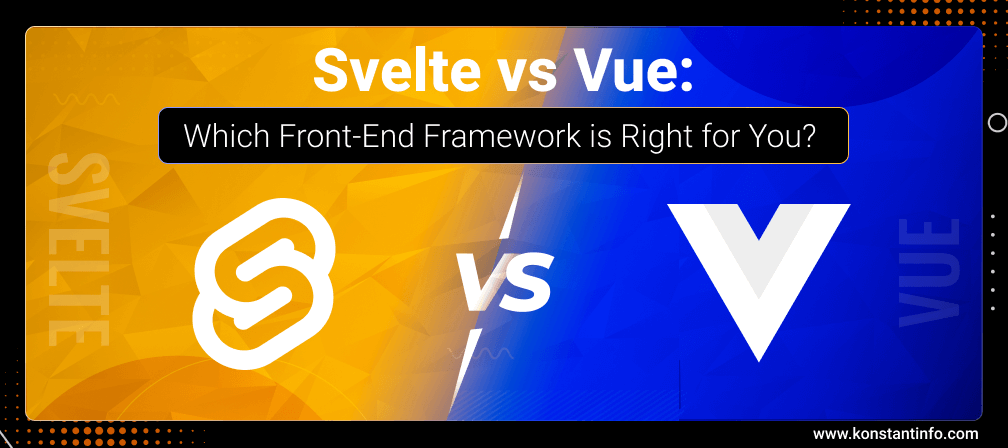
Svelte vs Vue – When choosing a front-end framework, there is no shortage of options such as AngularJS, React, Ember, and so on. As the Svelte and Vue.js frontend framework enters the ring, the competition becomes more intense.
The popularity of these two frontend frameworks outshined the frameworks such as Angular and React. Nowadays, frontend developers most commonly use the Svelte and Vue frameworks to develop simple, clean and organized user interfaces.
If you are also a frontend developer or business owner confused about which one you should choose i.e. Svelte or Vue, then this blog is meant for you.
In this article, we’ll provide you with a detailed overview of the frontend development frameworks of Svelte and Vue alongside comparing both of them with each other on a variety of aspects.
Svelte is an open-source JavaScript framework used to develop fast, lean, and developer-friendly websites and web apps.
The initial version of Svelte was launched in November 2016 by Rich Harris.
As opposed to other JavaScript frameworks, Svelte compiles UI components into efficiently compiled imperative code without the need for a virtual DOM that updates the DOM directly.
Svelte draws its power from the fact that it transfers much of the rendering to a compilation stage, thus you can expect a higher speed.
Here is a list of a few of the features of the Svelte framework that makes it the most beloved frontend development framework among the community.
When it comes to web application development, what eats up the most of the time? The process of writing the thousands of lines of code to power up the web application.
This is where Svelte comes out as the most favored JavaScript framework. Using it facilitates the developers to write fewer lines of code and follow basic syntaxes which further ease the development process.
What makes the Svelte more developer-friendly is its ability to create multiple top-level elements which make it easy for developers to update the local state of the variables.
To illustrate how Svelte reduces the amount of code the developers need to write, take the reference of the following two graphics.
Take a look at the Svelte version first.

Image credit: https://svelte.dev
Let’s see how Vue.js handles building this? That probably looks like this:

Image credit: https://svelte.dev
Rather than refer to a framework, Svelte is usually referred to as a compiler. The reason is that Svelte compiles directly from the .js file on the page to render the apps, so it does not load the entire library into the browser to run the code of Svelte. Furthermore, since all objects are updated only at compile-time, it also reduces the overhead generated by the virtual DOM.
Unlike the other JavaScript frontend frameworks like React and Vue, in which developers have to write declarative state-driven code. With declarative state-driven code, browsers are forced to do extra work in order to convert it to DOM behavior, which they can do by using techniques such as virtual DOM diffing. As a result, your frame budget will be squeezed and garbage collectors will be taxed.
There are advantages and disadvantages to everything we experience in life. The Svelte also comes with both benefits and drawbacks that we will discuss here.
1. Easily Usable
It doesn’t take a lot of time and effort to get started using Svelte since it’s simple to use. Alternatively, code can be written directly into a .html or .svelte file. As a result, Svelte becomes an easier tool to use when developing web applications.
2. Reduced Overhead
You can reduce the amount of overhead generated by JavaScript frameworks with Svelte. JavaScript compilers convert Svelte into vanilla JavaScript, improving code readability and reusability. As a result, web applications are developed more rapidly.
3. No Virtual DOM Compilation
The application and browser are connected via fewer layers of digital communication in Svelte, resulting in faster work and enhanced optimization. As a result, Svelte performance is increased.
4. Automated Updates
In Svelte, you can update your data automatically thanks to its declared variables. A more enhanced user experience is now available without waiting for the application to reflect the changes.
1. Lack of Community Support
The Svelte JavaScript framework is still a young one and is still not capable enough to compete with other frameworks commonly used today in terms of community support. Thus it might take a longer time to find answers to your questions related to the Svelte.
2. Lack of Svelte Development Tools Choices
Since Svelte is a relatively new framework, there are not too many development tools available for the framework. Hence developers need to do a lot of development tasks on their own that can be automated with other JavaScript frameworks such as React, AngularJS, and so on.
3. No Cross-Platform Development
Nowadays, most developers prefer to work with the frameworks that enable them to create cross-platform applications with similar code or with very few changes in the codebase. However, when using the Svelte web development framework, cross-platform development will have to be completely ignored. This is certainly one of the biggest drawbacks of the use of the Svelte framework.
In spite of being a new entrant in the race of frontend development frameworks, Svelte has managed to add a few of the most recognizable brands of the world to its portfolio including:
Lightweight, flexible, free and open-source, are a few of the terms that can be used to describe the Vue.js JavaScript framework. It is primarily used for the purpose of creating interactive web interfaces but can also be used for single-page applications development as well.
The initial version of the Vue.js was first launched in the year 2014, and ever since then, it has taken the world of front-end web development by storm.
When it comes to architecture, Vue or Vue.js is very similar to React and Angular. Due to this fact, the Vue.js based web applications can offer easy transitions in comparison to other frameworks.
When we talk about the features of the Vue.js- the progressive JavaScript framework the following features takes the lead:
Virtual DOM
The first talkative feature of the Vue JavaScript framework is its virtual DOM. Instead of altering the DOM, all changes are made to the JavaScript data structure that is a replica of the DOM. Each change you make will be stored in the Javascript data structure and compared to the original. It will be possible for developers to preview the changes, and if they are satisfied, they can proceed with the final changes to the DOM.
Data Binding
As part of the Vue.js framework, a binding directive called v-bind is available that allows you to set variables and HTML attributes, modify the style and assign classes.
Transitions & Animations
The Vue.js framework enables various types of transitions that can be used to add, update, or remove HTML elements from the DOM. In Vue.js, a transition component is included that must be added to an element to create the effect of a transition. A third-party animation library can easily be added and the interface can be made interactive.
1. Easy to Learn
As stated earlier, Vue.js is a lightweight, flexible, and versatile JavaScript framework, which is what most appeals to developers. Anyone who has some prior experience in frontend development can easily master the Vue.js progressive JavaScript framework.
2. Community and Support
Some of the most popular JavaScript frameworks like AngularJS are backed by Google, ReactJS is backed by Facebook, and Vue.js is something entirely backed by its open-source community. Contributors and developers contribute huge amounts of time and energy to keep Vue running. As a member of a huge community, you are assured of excellent support that allows you to solve your questions in the shortest amount of time.
3. Model-View-View-Model (MVVM) Architecture
Vue.js is driven by the model-view-view-model architecture that goes a long way to allow developers to craft excellent user interfaces. Also, this architecture has been proven to simplify user-interface-event-driven programming, thereby improving the performance of the system.
4. Best Version of Both Angular and React
Vue.js is made up of two of the greatest JavaScript frameworks i.e. React and Angular. The combination of these two allows for the creation of fast and interactive web applications.
For example, React is popular as it is component-based and makes use of the virtual DOM environment to speed up the working time of the web applications. While on the other hand, AngularJS has its own capabilities which include Directives and 2-Way Data Binding.
1. Lack of Scalability
Regarding the current usages of Vue.js, it is mostly applied to developing single-page applications and the user interface. However, when it comes to developing complex web apps, Vue.js lacks scalability.
2. Limited Resource
Despite the emerging popularity of the Vue.js framework, it still has a long way to go in terms of the number of plugins available in comparison to its rival frontend development frameworks.
3. Difficulties With Two-Way Binding
Vue developers also struggle with its two-way binding, which makes it difficult to use for the frontend developers.
In two-way binding, reactivity redraws only the components that have been changed and errors are thrown on reading. The data must therefore be flattened to be properly processed.
Some of the world’s most renowned brands that are using the Vue.js frontend framework to build interactive user interfaces are mentioned below:
Making a wise decision regarding what frontend development framework to choose is one of the most important tasks at the start of the project. A number of factors come into view while making the selection, and here is a brief outline of some of them:
A framework’s user interface provides developers with a means of communicating effortlessly with the collection of screens or visual elements.
When it comes to the Svelte framework, it features an aesthetically designed smart UI. The component-based user interface design of Svelte contributes to a positive and powerful user experience by reducing the loading time by eliminating the need for virtual DOM.
On the subject of the Vue user interface, it uses the virtual DOM to ensure that changes are not directly reflected on the screen. This allows designers to experiment more freely with their designs. Moreover, Vue.js supports the data binding feature called v-bind, which makes it easier for developers to modify HTML attributes at any time without affecting existing code.
Verdict: Vue.js takes the lead in terms of the user experience thanks to its virtual DOM environment which prompts the developer’s experiment skills, as a result, leads to better user interface design.
The size of the application is another factor that influences the choice of the JavaScript framework.
Svelte is considered to be the most accessible JavaScript component library which prompts the faster development of the applications. It has an application size of 4.1Kb which is pretty impressive in comparison to other Javascript frontend frameworks such as AngularJS, React, and so on.
Also, Vue is a lightweight JavaScript framework that allows you to create UI components for your web apps. It has an application size of 33.30Kb excluding the gzip.
Verdict: In terms of the application size between the Vue and Svelte, Svelte takes the lead.
How easy it is for developers to get familiar with the framework is also an important factor to be taken care of.
There is no steep learning curve with Svelte. Developers with a slight knowledge of JavaScript can go along with the Svelte. Also, it comes with plenty of reusable components built using HTML, CSS, and JavaScript to ease the process of building apps with Svelte.
Vue also has a smooth learning curve. Anyone familiar with ECMAScript 6 and basic skills of the JavaScript programming language can get familiar with the Vue.js framework with minimal effort.
Verdict: In terms of the learning curve, both Svelte and Vue have a smooth learning curve which makes it easy for the developers to onboard with the framework. Between the Sevelte and the Vue, it would be better to call it a draw in terms of a learning curve.
Above all else, performance matters.
The Svelte compiler is capable of producing and optimizing code in just one step, so improvements in performance are greatly favored. The additional benefit is that it eliminates the need for DOM, reducing the runtime greatly.
In contrast, Vue also makes use of the virtual DOM to enhance the performance of the application, but still, the performance of the Vue framework is not as good as that of Svelte.
Verdict: In terms of performance Svelte takes the lead.
When you are looking for rapid development, which frontend framework between Vue vs Svelte provides the best result?
With Svelte, you will no longer have to write extra compilation code since it eliminates the requirement that the code is compiled before the final user interface is made available.
While on the other hand, Vue is characterized by its lightweight nature and rendering features which prompt the developers towards rapid application development. Furthermore, it also has several add-ons to offer such as Bit, StoryBook, Vue dev-tools, and web packs like Vue loader to fasten the application development process.
Verdict: In terms of the development speed, Vue.js takes the lead thanks to its external add-ons support and rendering functionality.
No matter if it’s a web application or a mobile application, it will consist of hundreds or thousands of lines of code, so having convenience regarding code maintenance is highly desired.
Svelte is driven by modern-application development and made up of the components. It keeps all the components separate from each other, thus maintaining them becomes a lot easier.
On the other hand, Vue is still an ever-growing framework and lacks community support. With the Vue, maintainability is easier but not at the same level as with the Svelte.
Verdict: Svelte turns out to be a winner in the context of code maintainability thanks to its modern development approach.
Among Svelte vs Vue, which offers better security?
Svelte has yet to divulge any information about its security practices, not even on its official website.
While on the other side, Vue’s built-in sanitizer can automatically protect against attacks like XSS and other vulnerabilities. In this way, it leads towards the development of more secure web apps.
Verdict: Vue takes the lead in the context of security thanks to its automatic protection system against vulnerabilities attacks.
Regardless of how precisely your developers developed your project, testing is an important step that shouldn’t be overlooked.
The small size of Svelte libraries and the reduction in computation required to allow it to generate more testable code. Due to this, we can write more testable code which makes it more business-friendly.
In comparison, Vue has fewer testing capabilities, but it has straightforward testing capabilities.
Verdict: Svelte has better testing capabilities in comparison to the Vue framework.
Scalability is a key consideration for businesses that expect to expand over the coming years.
As previously mentioned, Svelte is a compiler-based framework, which allows a user to write and optimize code simultaneously. So we can say that Svelte is not the perfect solution to build scalable solutions. It can, however, be used in conjunction with other frameworks which allows it to be used to develop scalable, reusable components.
Considering Vue, it’s a lightweight framework that is often recommended as a choice for small-scale applications development. Hence scalability is not something that you can expect from the Vue.
Verdict: With respect to scalability, Svelte and Vue have a long way to go. But still Svelte takes the lead here as it is more scalable in comparison to Vue.
Having learned all about the Vue vs Svelte framework, the next question you may have is which one to select.
As you can see, we have discussed some relevant use cases when Svelte or Vue might prove to be an excellent choice:
It doesn’t matter whether it is Vue vs Svelte, every frontend JavaScript framework has its pros and cons. In this case, it is recommended to speak to experienced frontend developers for an informed selection of the right framework that perfectly aligns with your projects.
This is a question with contradicting answers. Some developers who prefer the performance of the framework above all believe Svelte has better capabilities than Vue. While on the other hand developers who favor rapid development and best security practices believe that Vue is a better framework. This is why it is not inaccurate to say that the answer to this question greatly depends on your project requirements.
In short, the answer is yes. The advantage of Svelte is that it writes and optimizes code at the same time, so it is faster than Vue. The downside with the Svelte is that it won’t be able to run on a browser without the compilation step.
In such a case, Vue comes to be an ideal choice as it shares similar structure and elements from React and Angular too. As a result, you won’t experience any problems in switching.
Here are a few practices you can follow to hire reliable Svelte or Vuejs developers for your next project:



Being indulged in the IT industry for more than 3+ years, I aim to offer up-to-date and latest knowledge on different technologies and trends setting the market. This is what I love to do. When I'm not working, I like to be near the outdoors surrounded by greenery.
Or send us an email at: [email protected]